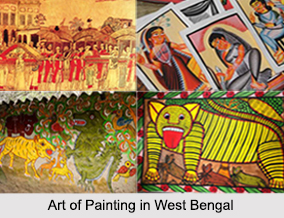 The history of art of painting in West Bengal goes back to the early 8th century during the rule of the Pala Empire. This period was part of the late classical period and has pictorial inscriptions on palm leaves and terracotta plaques, which are now unique and identical features of Bengali art. Influenced by the Gupta art, the Pala School of sculptural art is recognised as a distinct phase of the Indian art, and is noted for the artistic genius of the Bengal sculptors. The history of art of painting in West Bengal goes back to the early 8th century during the rule of the Pala Empire. This period was part of the late classical period and has pictorial inscriptions on palm leaves and terracotta plaques, which are now unique and identical features of Bengali art. Influenced by the Gupta art, the Pala School of sculptural art is recognised as a distinct phase of the Indian art, and is noted for the artistic genius of the Bengal sculptors.
After the reign of the Pala dynasty, Bengal art went underground for almost 800 years until the arrival of the Mughal Empire in the early 18th century. The city of Kolkata became the centre of the colonial rule and the artists from Murshidabad, Patna and Ayodhya arrived in the city for work. These provincial artists were quick to adapt the technique and the traditional knowledge of art and termed it as ‘Company Art’. Artisans like Pir Bux, Shaikh Zainuddin and a few others excelled in this style. But the finest of them undoubtedly was Sheikh Muhammad Ameer, who was active around 1840-50. His paintings depicting animals could well be compared with any of the best European examples of the period. During this time and the late 19th century, the Kalighat Patachitra has been a major part of the history of art of painting in West Bengal. This style of painting originated after the colonial rule and had destroyed the equilibrium of the Bengal village life. It was because of this, the Patuas began losing their livelihood. As a result, the Patuas from the various districts of West Bengal, namely, 24 Paraganas, Howrah and Medinipur, thronged around the Kalighat temple and started selling paintings of deities done on cheap paper in local watercolour to devotees and pilgrims. The Kalighat Patachitras derived definite inspirations from folk dolls and statuettes. Bengali folk art has few distinctive features like the decent segmentation in designs, repetition of forms and aesthetically vivid colours. Repetition of common motifs like the water lily, the sun, the tree-of-life, flowery creepers, fish, elephant, horse, peacock, waves, temple, mosque etc. are commonly seen in paintings, embroidery, weaving, carving and engraving. Folk literature has also been of great influence and is a part of the history of art of painting in West Bengal. The colours used in the paintings are symbolic as the Bengali poets have used colours to resonate with emotions and elements of nature, like the colour black is used for darkness, green for earth, white for peace and serenity, blue for warmth and red is for fire or rage. Thus, it can be said that the history of art of painting in West Bengal is seeped with culture, vibrant colours and a nuanced combination of few other art forms. The Bengali folk art is unique in style. |
| |||
Home > Art & Culture > Indian Paintings > Indian Folk Painting > Folk Paintings of West Bengal > History of Art of Painting in West Bengal
History of Art of Painting in West Bengal
| The history of art of painting in West Bengal is a part of the Bengali folk art and is a part of the culture and heritage of the state. |
| ||||||||||||||||||||||||||||













